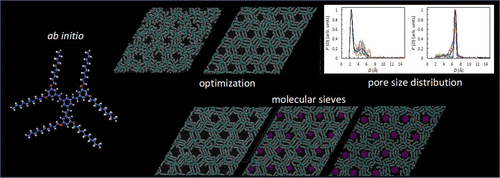当前位置:
X-MOL 学术
›
J. Chem. Inf. Model.
›
论文详情
Our official English website, www.x-mol.net, welcomes your
feedback! (Note: you will need to create a separate account there.)
Self-Assembled Two-Dimensional Nanoporous Crystals as Molecular Sieves: Molecular Dynamics Studies of 1,3,5-Tristyrilbenzene-Cn Superstructures.
Journal of Chemical Information and Modeling ( IF 5.6 ) Pub Date : 2020-03-10 , DOI: 10.1021/acs.jcim.0c00015 Alexander St John 1 , Michael W Roth 1, 2 , Lucyna Firlej 1, 3 , Bogdan Kuchta 1, 4, 5 , Fabrice Charra 6 , Carlos Wexler 1
Journal of Chemical Information and Modeling ( IF 5.6 ) Pub Date : 2020-03-10 , DOI: 10.1021/acs.jcim.0c00015 Alexander St John 1 , Michael W Roth 1, 2 , Lucyna Firlej 1, 3 , Bogdan Kuchta 1, 4, 5 , Fabrice Charra 6 , Carlos Wexler 1
Affiliation

|
Due to their unique geometry complex, self-assembled nanoporous 2D molecular crystals offer a broad landscape of potential applications, ranging from adsorption and catalysis to optoelectronics, substrate processes, and future nanomachine applications. Here we report and discuss the results of extensive all-atom Molecular Dynamics (MD) investigations of self-assembled organic monolayers (SAOM) of interdigitated 1,3,5-tristyrilbenzene (TSB) molecules terminated by alkoxy peripheral chains Cn containing n carbon atoms (TSB3,5-Cn) deposited onto highly ordered pyrolytic graphite (HOPG). In vacuo structural and electronic properties of the TSB3,5-Cn molecules were initially determined using ab initio second order Møller-Plesset (MP2) calculations. The MD simulations were then used to analyze the behavior of the self-assembled superlattices, including relaxed lattice geometry (in good agreement with experimental results) and stability at ambient temperatures. We show that the intermolecular disordering of the TSB3,5-Cn monolayers arises from competition between decreased rigidity of the alkoxy chains (loss of intramolecular order) and increased stabilization with increasing chain length (afforded by interdigitation). We show that the inclusion of guest organic molecules (e.g., benzene, pyrene, coronene, hexabenzocoronene) into the nanopores (voids formed by interdigitated alkoxy chains) of the TSB3,5-Cn superlattices stabilizes the superstructure, and we highlight the importance of alkoxy chain mobility and available pore space in the dynamics of the systems and their potential application in selective adsorption.
中文翻译:

自组装二维纳米多孔晶体作为分子筛:1,3,5-三苯乙烯苯-Cn超结构的分子动力学研究。
由于其独特的几何形状复杂性,自组装的纳米多孔2D分子晶体提供了广泛的潜在应用前景,从吸附和催化到光电,衬底工艺以及未来的纳米机械应用。在这里我们报告并讨论了广泛的全原子分子动力学(MD)研究结果的自组装的有机单层(SAOM)的相互交叉的1,3,5-三苯乙烯苯(TSB)分子终止于烷氧基外围链Cn包含n个碳原子(TSB3,5-Cn)沉积在高度有序的热解石墨(HOPG)上。在真空中,TSB3,5-Cn分子的结构和电子性质最初是使用从头开始的二阶Møller-Plesset(MP2)计算确定的。然后使用MD模拟来分析自组装超晶格的行为,包括宽松的晶格几何形状(与实验结果高度吻合)和在环境温度下的稳定性。我们表明,TSB3,5-Cn单分子层的分子间无序是由于烷氧基链的刚性下降(分子内顺序的丧失)和链长的增加(通过叉指化)而增加的稳定性之间的竞争引起的。我们表明,TSB3,5-Cn超晶格的纳米孔(由相互交叉的烷氧基链形成的空隙)中包含客体有机分子(例如,苯、,、,、六苯并二甲苯)稳定了超结构,并且我们强调了烷氧基的重要性动力学中的链迁移率和可用孔隙空间及其在选择性吸附中的潜在应用。
更新日期:2020-03-10
中文翻译:

自组装二维纳米多孔晶体作为分子筛:1,3,5-三苯乙烯苯-Cn超结构的分子动力学研究。
由于其独特的几何形状复杂性,自组装的纳米多孔2D分子晶体提供了广泛的潜在应用前景,从吸附和催化到光电,衬底工艺以及未来的纳米机械应用。在这里我们报告并讨论了广泛的全原子分子动力学(MD)研究结果的自组装的有机单层(SAOM)的相互交叉的1,3,5-三苯乙烯苯(TSB)分子终止于烷氧基外围链Cn包含n个碳原子(TSB3,5-Cn)沉积在高度有序的热解石墨(HOPG)上。在真空中,TSB3,5-Cn分子的结构和电子性质最初是使用从头开始的二阶Møller-Plesset(MP2)计算确定的。然后使用MD模拟来分析自组装超晶格的行为,包括宽松的晶格几何形状(与实验结果高度吻合)和在环境温度下的稳定性。我们表明,TSB3,5-Cn单分子层的分子间无序是由于烷氧基链的刚性下降(分子内顺序的丧失)和链长的增加(通过叉指化)而增加的稳定性之间的竞争引起的。我们表明,TSB3,5-Cn超晶格的纳米孔(由相互交叉的烷氧基链形成的空隙)中包含客体有机分子(例如,苯、,、,、六苯并二甲苯)稳定了超结构,并且我们强调了烷氧基的重要性动力学中的链迁移率和可用孔隙空间及其在选择性吸附中的潜在应用。











































 京公网安备 11010802027423号
京公网安备 11010802027423号